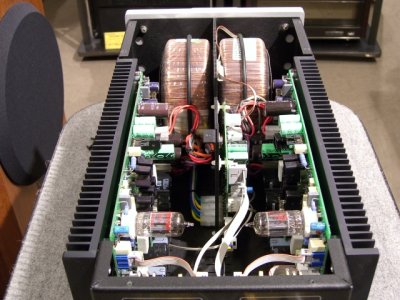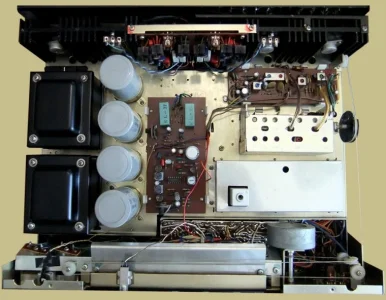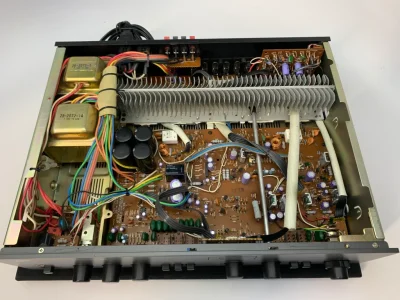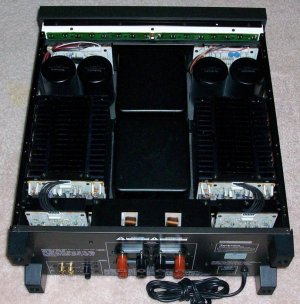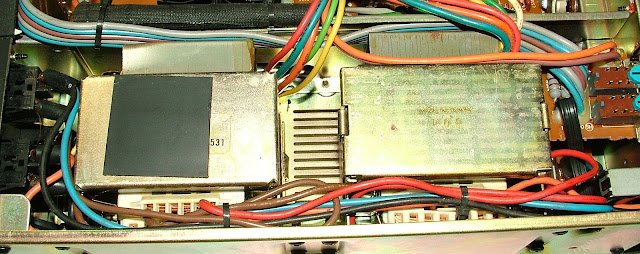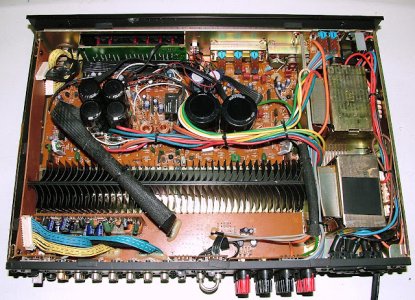You are using an out of date browser. It may not display this or other websites correctly.
You should upgrade or use an alternative browser.
You should upgrade or use an alternative browser.
Can you get a Dual Mono sound by using two AVRs?
- Thread starter rwnano
- Start date
Passive_audio_enthusiast
Well-Known Member
If you have two identical AVRs and have one benefit of a true dual mono- having no crosstalk between left and right channels.I mean - like two monoblock amplifiers ? Like the fosi V3 dual mono?
in the above scheme : -
1. Take the RED RCA cable to AVR 1
2. Take the WHITE RCA cable output to AVR 2
from the DAC.
and Run only 1 FRONT speaker from each AVR
Paul is saying "go for it - and it should be a fun experiment"
the sound quality which you are going to have is limited to the performance of the AVRs channels which you are using. If the speakers support biamping, then probably you can use two channels of the avr to one speaker(using some stereo to multichannel mode like all channel stereo). There can be a small improvement in sound depending on how your avr is designed.
It all depends on which avr you are having. Some higher end AVRs sound better than some mid or low end stereo amps.
availlyrics
Well-Known Member
- Joined
- Sep 26, 2011
- Messages
- 348
- Points
- 63
One thing that needs to be considered with dual mono design is that there are now 2 seperate grounds as each Transformer's centre tap is ground for the amp section it's powering. This requires careful PCB layout to avoid ground loops.
rwnano
Well-Known Member
In my case I think that yes, my speakers do soak up the current and dip down to low resistance values.If you have two identical AVRs and have one benefit of a true dual mono- having no crosstalk between left and right channels.
the sound quality which you are going to have is limited to the performance of the AVRs channels which you are using. If the speakers support biamping, then probably you can use two channels of the avr to one speaker(using some stereo to multichannel mode like all channel stereo). There can be a small improvement in sound depending on how your avr is designed.
It all depends on which avr you are having. Some higher end AVRs sound better than some mid or low end stereo amps.
This is because they are transmission line speakers with less sensitivity - their back wave is absorbed and reflected out and at high bass occasions they would soak up the current.
In that scenario, dual monoblocks makes sense due to two transformers with no interference between the currents of the transformers and thus no crosstalk between left and right channels.
My AVR has a high current capacity of peak 28 amperes. 65 watts RMS each channel in stereo mode.
rwnano
Well-Known Member
rwnano
Well-Known Member
Manufactured from 1976-1980, a fully DC power amplifier, 100w + 100w 8ohms, "mirror image" VFET output pairs, 2 per channel, super circuits and independent L&R power supplies. According to the B2 manual, Yamaha was the first Japanese company to use seperate power transformers in a power amplifier in the B1 (1974-1980).
rwnano
Well-Known Member
rwnano
Well-Known Member

Norma 140 Integrated Amplifier
I recently revisited a book so rich in historical detail and visually evocative that one feels as if air-dropped onto the unpaved, rough-and-tumble,
Powering the IPA-140 are a pair of toroidal transformers, separate power supplies for gain, output, and driver stages, and six per-side MOSFET power devices rated at 150A peak output current.

Last edited:
rwnano
Well-Known Member
Harman kardon twin power 930
 classicreceivers.com
classicreceivers.com
Harman Kardon 930 | Classic Receivers
The Harman Kardon 930 receiver is a great receiver. Its unique dual power supply design gives it a place in audio engineering history as well as a great sound.
Attachments
IndianEars
Well-Known Member
Nice Pics, rwnano 
square_wave
Well-Known Member
This is the first time I am seeing some trying to do what you are planning to do using AVRs. Usually, people do this with 2 power amplifiers. Such power amplifiers are designed to be bridgeable to mono. And these amps (by design) takes into account many technical things to make that a seamless operation.
Most amplifiers are designed to handle the thermal load when both channels are driven. Using only one channel typically does not pose a thermal risk, but it's essential to ensure the amplifier is not overloaded beyond its specifications for that single channel.
Are you planning to use some hard to drive loudspeaker by doing this ? Apart from such a "drivability" problem, I don't see you gaining anything else in terms of sound quality if you use a pair of AVRs for doing this. There are bigger issues with AVRs specific to parameters that contribute to overall sound quality that you cannot fix with what you are proposing to do.
Also, although a very drastic solution, you could ask a diy amp maker to internally make changes to both the AVRs to isolate just the power amp section and make them bridgeable to mono. You can remove all the other noise creating circuits from the equation. Also maybe upgrade the caps etc. to get better sound too.
Most amplifiers are designed to handle the thermal load when both channels are driven. Using only one channel typically does not pose a thermal risk, but it's essential to ensure the amplifier is not overloaded beyond its specifications for that single channel.
Are you planning to use some hard to drive loudspeaker by doing this ? Apart from such a "drivability" problem, I don't see you gaining anything else in terms of sound quality if you use a pair of AVRs for doing this. There are bigger issues with AVRs specific to parameters that contribute to overall sound quality that you cannot fix with what you are proposing to do.
Also, although a very drastic solution, you could ask a diy amp maker to internally make changes to both the AVRs to isolate just the power amp section and make them bridgeable to mono. You can remove all the other noise creating circuits from the equation. Also maybe upgrade the caps etc. to get better sound too.
rwnano
Well-Known Member
Hi sir. thank you for your response.This is the first time I am seeing some trying to do what you are planning to do using AVRs. Usually, people do this with 2 power amplifiers. Such power amplifiers are designed to be bridgeable to mono. And these amps (by design) takes into account many technical things to make that a seamless operation.
Most amplifiers are designed to handle the thermal load when both channels are driven. Using only one channel typically does not pose a thermal risk, but it's essential to ensure the amplifier is not overloaded beyond its specifications for that single channel.
Are you planning to use some hard to drive loudspeaker by doing this ? Apart from such a "drivability" problem, I don't see you gaining anything else in terms of sound quality if you use a pair of AVRs for doing this. There are bigger issues with AVRs specific to parameters that contribute to overall sound quality that you cannot fix with what you are proposing to do.
Also, although a very drastic solution, you could ask a diy amp maker to internally make changes to both the AVRs to isolate just the power amp section and make them bridgeable to mono. You can remove all the other noise creating circuits from the equation. Also maybe upgrade the caps etc. to get better sound too.
I have Fried - Irving M Bud Fried's 1997 made Signature A 6 transmission line speakers. They are less sensitive due to the transmission lines - they tend to soak up the current.
It's not that the speakers are undriveable currently. They play well with a single AVR too.
My AVR is Harman Kardon AVR with 28 Amperes peak current capability and 13 kg weight. 65 watts RMS in stereo.
I am planning to get another identical AVR.
As shown in the examples of pictures above - a lot of the high end amplifiers tend to have separate power supplies , plus one transformer per channel. I am aiming to achieve the same effect by using two identical AVRs - one per channel.
I was seeking more channel separation and perhaps better sound?
I don't know if I will get it. Psychoacoustics effects are powerful. But I can try to emulate what I see in high end amplifiers.
Regarding the DiY modifications route - I don't think I have the bandwidth to make the DiY modifications happen.
rwnano
Well-Known Member
please do elaborate on these bigger issues.There are bigger issues with AVRs specific to parameters that contribute to overall sound quality that you cannot fix with what you are proposing to do.
this is my AVR:
https://www.hifiengine.com/manual_library/harman-kardon/avr3550.shtml
square_wave
Well-Known Member
Those are classic speakers and well known for sounding great. I remember talking to a gentleman about the same speakers many years ago. That AVR is an older model and probably don't suffer the sound quality issues that plaque the newer low to mid budget models in the market today. However it may make sense to buy a dedicated stereo amplifier with dual transformers and good power supply design rather than buying another AVR.
AVRs in general are "all in one" devices. Audio quality is generally better when one keeps the design simple and free of noise generating circuits in the signal chain.
What is driving that decision to buy one more AVR rather than selling the existing AVR and buying a stereo amplifier? Are you a movie watcher too and use the surround function for that?
AVRs in general are "all in one" devices. Audio quality is generally better when one keeps the design simple and free of noise generating circuits in the signal chain.
What is driving that decision to buy one more AVR rather than selling the existing AVR and buying a stereo amplifier? Are you a movie watcher too and use the surround function for that?
rwnano
Well-Known Member
1. You're right. You're right that it may make sense to buy a dedicated stereo amplifier with dual everything.Those are classic speakers and well known for sounding great. I remember talking to a gentleman about the same speakers many years ago. That AVR is an older model and probably don't suffer the sound quality issues that plaque the newer low to mid budget models in the market today. However it may make sense to buy a dedicated stereo amplifier with dual transformers and good power supply design rather than buying another AVR.
AVRs in general are "all in one" devices. Audio quality is generally better when one keeps the design simple and free of noise generating circuits in the signal chain.
What is driving that decision to buy one more AVR rather than selling the existing AVR and buying a stereo amplifier? Are you a movie watcher too and use the surround function for that?
2. I'm not a movie watcher; What's driving the decision to buy one more AVR is expense: modern amplifiers are very expensive to acquire - especially the ones with heavy, large transformers and circuitry which can reach high current capability. 1000's of USD.
square_wave
Well-Known Member
Consider Indian manufacturers like O&B or Acoustic portrait for high quality alternatives to keep costs low. You should get something below 1000 USD that will easily beat anything in the price range from mainstream international brands. They keep costs low due to lesser overheads. Also they focus on sound quality for 2 channel needs.1. You're right. You're right that it may make sense to buy a dedicated stereo amplifier with dual everything.
2. I'm not a movie watcher; What's driving the decision to buy one more AVR is expense: modern amplifiers are very expensive to acquire - especially the ones with heavy, large transformers and circuitry which can reach high current capability. 1000's of USD.
rwnano
Well-Known Member
rwnano
Well-Known Member
rwnano
Well-Known Member
Wharfedale Linton Heritage Speakers in Red Mahogany finish at a Special Offer Price. BUY now before the price increase.
Similar threads
- Replies
- 0
- Views
- 8K
- Replies
- 8
- Views
- 10K
- Replies
- 2
- Views
- 9K
- Replies
- 0
- Views
- 10K



